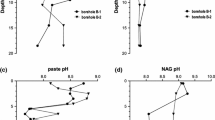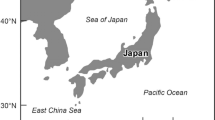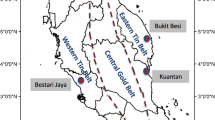Abstract
Mine tailings left at abandoned sulfide mine sites can seriously threaten surrounding ecosystems and cause soil and water pollution. This study focused on determining the geochemical processes and mineral phases controlling metal cycling in an abandoned copper mine site (Kuvarshan, Artvin, northeastern Turkey). Geochemical and mineralogical characterization studies were conducted to determine the chemical and mineral compositions of the tailings, leachates, and AMD products. In addition, kinetic tests and geochemical modeling studies were performed on the tailings to evaluate the rates and mechanisms of metal release. Oxidation of pyrite in the tailings played an important role in the formation of acidic mine drainages (pH ≈ 2.7–3.1) with high sulfate and metal contents. Sequestration of Fe and As in the AMD was controlled by jarosite precipitation. A large fraction of the total Fe (73%) and As (98%) remained in the suspended phase in the acidic water. Furthermore, the local precipitation of aragonite from alkaline mine leachates also removed zinc, copper, arsenic, and lead ions from the solution, and minimized the release of these metals into the environment. On the other hand, dissolution of secondary sulfate mineral precipitates (i.e. chalcoalumite, chalcocyanite, goslarite, coquimbite, and rozenite) contributed to the enrichment of Al, Cu, Fe, Zn, As, and Pb in the mine leachates and metal loading into a nearby stream during the wet period.
Resumen
Los estériles de las operaciones mineras abandonadas en las que se han beneficiado sulfuros pueden suponer una grave amenaza para los ecosistemas del entorno y pueden causar la contaminación de suelos y aguas. Este estudio se centra en determinar los procesos geoquímicos y las especies minerales que controlan los ciclos de los metales en una mina de cobre abandonada, en Kuvarshan (Artvin, Noreste de Turquía). Con el objeto de determinar la composición geoquímica y mineralógica de los estériles, de sus lixiviados y de los productos derivados de los drenajes ácidos de mina, se realizaron diversos tipos de estudios. Además de lo anterior, se llevaron a cabo ensayos de cinética y estudios de modelización geoquímica sobre los estériles, con objeto de determinar las velocidades y los mecanismos de liberación de metales. La oxidación de la pirita presente en los estériles juega un papel relevante en la formación de drenajes ácidos de mina (pH ≈ 2,7-3,1), que presentan contenidos elevados en sulfatos y metales. La retención de Fe y As en los drenajes ácidos está controlada por la precipitación de jarosita, a pesar de que una gran proporción del Fe (73%) y del As (98%) permanece en foma de sólidos en suspensión en el drenaje ácido. Además, la precipitación, de forma local, de aragonito a partir de lixiviados alcalinos contribuye a la retención de Zn, Cu, As y Pb, eliminándolos parcialmente de la solución y minimizando así su liberación al medio ambiente. Por otra parte, la disolución de sulfatos secundarios (calcoalumita, calcocianita, goslarita, coquimbita y rozenita) contribuye al enriquecimientos de los lixiviados mineros en Al, Cu, Fe, Zn, As y Pb, aumentando por consiguiente la carga metálica del cauce receptor, un arroyo cercano, durante los periodos húmedos.
Zusammenfassung
Abraumhalden aus stillgelegten Sulfidminen können die umliegenden Ökosysteme ernsthaft bedrohen und eine Verschmutzung von Boden und Wasser verursachen. Diese Studie konzentrierte sich auf die Bestimmung der geochemischen Prozesse und Mineralphasen, die den Metallkreislauf in einer stillgelegten Kupfermine (Kuvarshan, Artvin, Nordosttürkei) steuern. Es wurden geochemische und mineralogische Charakterisierungsstudien durchgeführt, um die chemische und mineralische Zusammensetzung der Abraumhalden, der Sickerwässer und der Nebenprodukte von saurem Grubenwasser zu bestimmen. Darüber hinaus wurden kinetische Tests und geochemische Modellierungsstudien an den Abraumhalden durchgeführt, um die Raten und Mechanismen der Metallfreisetzung zu bewerten. Die Oxidation von Pyrit in den Abraumhalden spielte eine wichtige Rolle bei der Bildung saurer Abwässer (pH ≈ 2,7-3,1) mit hohen Sulfat- und Metallgehalten. Die Sequestrierung von Fe und As im sauren Grubenwasser wurde durch die Ausfällung von Jarosit gesteuert. Ein großer Teil des gesamten Eisens (73 %) und Arsens (98 %) verblieb suspendiert, d.h. in der Schwebephase des sauren Wassers. Außerdem entfernte die lokale Ausfällung von Aragonit aus alkalischen Minensickerwässern auch Zink-, Kupfer-, Arsen- und Blei-Ionen aus der Lösung und minimierte die Freisetzung dieser Metalle in die Umwelt. Andererseits trug die Auflösung sekundärer Sulfatmineralausfällungen (d. h. Chalkoalumit, Chalkocyanit, Goslarit, Coquimbit und Rozenit) zur Anreicherung von Al, Cu, Fe, Zn, As und Pb in den Grubensickerwässern und zur Metallbelastung eines nahe gelegenen Baches während der Regenzeit bei.
摘要
废弃硫化物矿区的矿山矿渣会严重威胁周围的生态系统,并造成土壤和水体污染。本项研究的重点是确定控制土耳其东北部阿尔特温废弃铜矿金属循环的地球化学过程和矿物相。通过地球化学和矿物学表征研究确定了矿渣、渗滤液和AMD产物的化学和矿物成分。此外,还对矿渣进行了动力学测试和地球化学模拟研究,以评估金属释出的速率和机制。矿渣中黄铁矿的氧化作用是形成高硫酸盐和高金属含量酸性矿井水(pH ≈ 2.7-3.1)的重要原因。黄钾铁矾的沉淀控制了 AMD 中铁和砷的隔离作用。大部分Fe(73%)和As(98%)保留在酸性水中的悬浮相中。此外,碱性矿山渗出液中的文石部分沉淀还能去除溶液中的锌、铜、砷和铅离子,并最大限度地减少了这些金属向环境中的释放。另一方面,次生硫酸盐矿物沉淀(即绿泥石、堇青石、皓矾、褐铁矿和菱铁矿)的溶解导致矿山渗出液中的Al、Cu、Fe、Zn、As和Pb富集,并在降雨期将金属排放到附近的溪流中。














Similar content being viewed by others
Data availability
All data were already given in paper.
References
ASTM (2001) Standard test method for accelerated weathering of solid materials using a modified humidity cell. American Society for Testing and Materials, Cham, pp 5744–5796
AWWA (1995) Standard methods for the examination of water and wastewater, 19th edn. American Water Works Association, Washington
Bethke CM (1998) The geochemist's workbench release 3.0. A users guide to Rxn, Act2, React, and Gtplot, Univ of Illinois, Urbana
Carbone C, Dinelli E, Marescotti P, Gasparotto G, Lucchetti G (2013) The role of AMD secondary minerals in controlling environmental pollution: indications from bulk leaching tests. J Geochem Explor 132:188–200
Çiftçi E, Yalçınalp B, Housh TB (2009) Ore mineralogy, Cu-S-Pb isotope- and base-precious metal geochemistry of the eastern Pontides volcanogenic massive sulfide deposits. In: Proceedings of 2nd International Symp on the Geology of the Black Sea Region, Ankara, p 44
De Choudens-Sanchez V, Gonzalez LA (2009) Calcite and aragonite precipitation under controlled instantaneous supersaturation: elucidating the role of CaCO3 saturation state and Mg/Ca ratio on calcium carbonate polymorphism. J Sediment Res 79(6):363–376
Dold B (2014) Evolution of acid mine drainage formation in sulphidic mine tailings. Minerals 4:621–641. https://doi.org/10.3390/min4030621
EPA (2007) Microwave assisted acid digestion of aqueous samples and extracts (EPA Method 3015A).
Hammarstrom JM, Seal RR, Meier AL, Kornfeld JM (2005) Secondary sulfate minerals associated with acid drainage in the eastern US: recycling of metals and acidity in surface environments. Chem Geol 215:407–431
Jacobs JA, Lehr JH, Testa SM (2014) Acid mine drainage, rock drainage, and acid sulfate soils: causes, assessment, prediction, prevention, and remediation. Wiley, Hoboken
Jambor JL, Nordstrom DK, Alpers CN (2000) Metal-sulfate salts from sulfide mineral oxidation. Rev Min Geochem 40:302–350
Kraeff A (1963) Geology and mineral deposits of the Hopa-Murgul region (western part of the province of Artvin, Turkey). MTA Bull 60:45–60
Lapakko K (2002) Metal mine rock and waste characterization tools: an overview. Mining, Minerals, and Sustainable Development (MMSD) working paper, 67. https://www.iied.org/g00559
Lottermoser B (2007) Mine wastes: characterization, treatment and environmental impacts. Springer
Miller FP, Vandome AF, McBrewster J (2009) Acid mine drainage. Alphascript Publishing, Aurora
Nordstrom DK (1982) Aqueous pyrite oxidation and the consequent formation of secondary iron minerals. In: Kittrick JA, Fanning DS, Hossner LR (eds) Acid sulfate weathering. Soil Science Society of America, pp 37–56
Nordstrom DK, Alpers CN (1999) Geochemistry of acid mine waters. In: Plumlee GS, Logsdon MJ (eds) The environmental geochemistry of mineral deposits, reviews in economic geology, 6th edn. Springer, pp 133–160
Simonovic R (1972) Report on geological 1:10000 mapping and prospecting in the Artvin area (Kuarshane, Sinkot, Irsa, Seyitli-Umasen), M.T.A. General Directory, Report 4912, Ankara, Turkey
Singer PC, Stumm W (1970) Acidic mine drainage: the rate-determining step. Science 167:1121–1123
Sunagawa I, Takahashi Y, Imai H (2007) Strontium and aragonite-calcite precipitation. J Miner Pet Sci 102(3):174–181
TÜBİTAK (2014) Geochemical processes controlling the generation and environmental impacts of acid mine drainage in the case of polymetallic mines, Artvin. Project 110Y235, Final report (in Turkish)
Van A (1990) Geochemistry, petrogenesis and massive sulfide mineralizations of the Artvin Region in the Pontide Belt. PhD Diss, Turkey Black Sea Tech Univ (in Turkish)
Zeller EJ, Wray JL (1956) Factors influencing precipitation of calcium carbonate. AAPG Bull 40(1):140–152
Acknowledgements
This research was supported by a grant 110Y235 provided by the Scientific and Technological Research Council of Turkey (TÜBITAK). We thank the anonymous reviewers for their constructive and detailed comments.
Author information
Authors and Affiliations
Corresponding author
Supplementary Information
Below is the link to the electronic supplementary material.
10230_2023_956_MOESM1_ESM.pdf
Supplementary file1 Fig. S-1 Fe and S species of weekly leachates obtained from the HCE on Eh-pH mineral stability diagram (results of K-15 waste rock were shown as an example.) (PDF 14 kb)
10230_2023_956_MOESM2_ESM.pdf
Supplementary file2 Fig. S-2 Mineral saturation indices of leachates released from waste rock during humidity cell test. Results of K-15 waste rock shown as an example. (PDF 53 kb)
10230_2023_956_MOESM3_ESM.pdf
Supplementary file3 Fig. S-3 Comparison of XRD images of mixtures obtained from the mine tailings samples between pre-and post HCEs. (PDF 337 kb)
10230_2023_956_MOESM4_ESM.pdf
Supplementary file4 Fig. S-4 XRD images of metahohmanite and copiapite precipitated during humidity cell tests. (PDF 324 kb)
Rights and permissions
Springer Nature or its licensor (e.g. a society or other partner) holds exclusive rights to this article under a publishing agreement with the author(s) or other rightsholder(s); author self-archiving of the accepted manuscript version of this article is solely governed by the terms of such publishing agreement and applicable law.
About this article
Cite this article
Yolcubal, I., Doğrul Demiray, A., Çiftçi, E. et al. Role of Secondary Sulfate Minerals on Metal Recycling in an Abandoned Copper Deposit: Kuvarshan (Artvin), Northeastern Turkey. Mine Water Environ 42, 560–577 (2023). https://doi.org/10.1007/s10230-023-00956-0
Received:
Accepted:
Published:
Issue Date:
DOI: https://doi.org/10.1007/s10230-023-00956-0




